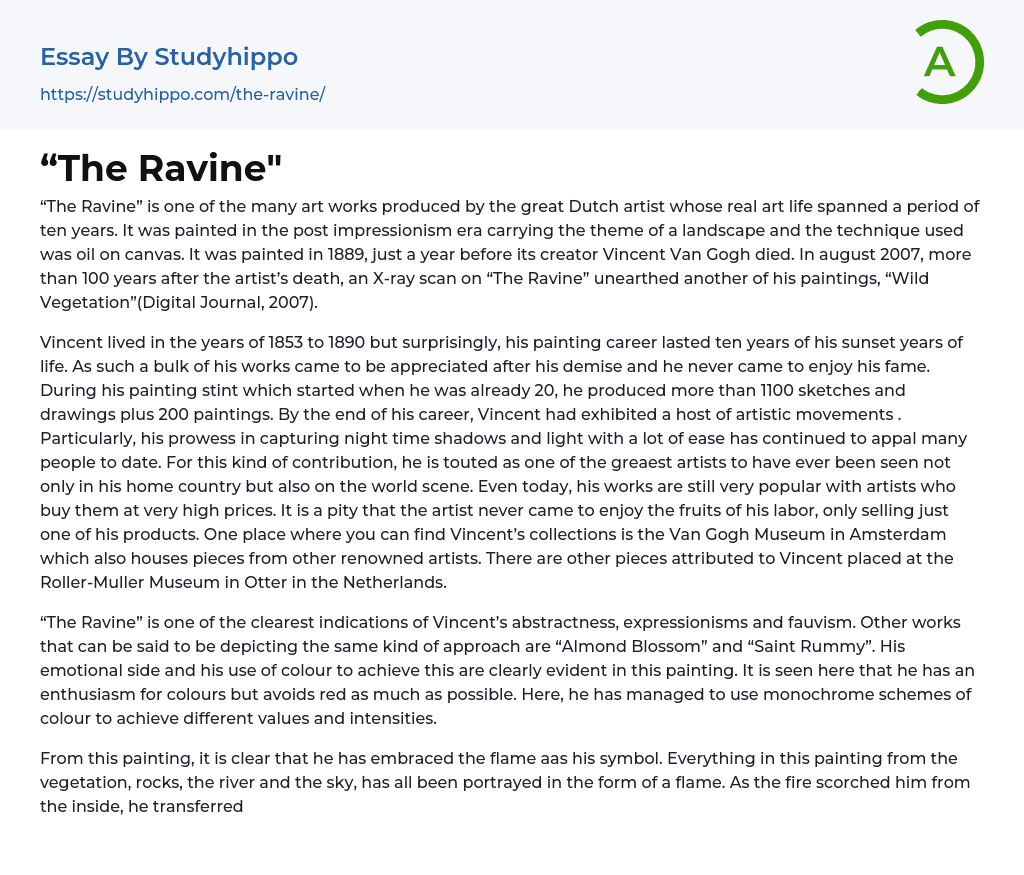"The Ravine" is a landscape artwork painted in the post impressionism era by Vincent Van Gogh. Created in 1889 with oil on canvas, it was completed just a year before the artist's death. In August 2007, an X-ray scan of "The Ravine" revealed another one of Van Gogh's paintings titled "Wild Vegetation" (Digital Journal, 2007).
Vincent's painting career spanned from 1853 to 1890, covering the last ten years of his life. Surprisingly, most of his works gained appreciation after his death, and he never experienced personal fame. During this period, which began at the age of 20, he created over 1100 sketches and drawings in addition to 200 paintings. By the end of his career, Vincent explored different artistic movements and became renowned for his ability to capture nighttime shadows and light. Today, he is recognized as one of the greatest artists both in his ho
...me country and internationally. His works continue to be highly sought after by artists who are willing to pay exorbitant prices for them. Unfortunately, Vincent only sold one artwork during his lifetime and was unable to enjoy the rewards of his labor.
The Van Gogh Museum in Amsterdam houses collections of Vincent's art alongside pieces by other renowned artists. The Roller-Muller Museum in Otter in the Netherlands also exhibits other artworks attributed to Vincent.
"The Ravine" is a clear example of Vincent's abstractness, expressionism, and fauvism. Other works that follow a similar approach are "Almond Blossom" and "Saint Rummy". The painting showcases Vincent's emotional side and his use of color to convey his emotions. Interestingly, he shows enthusiasm for colors but purposely avoids using red. In this artwork, Vincent skillfully employs monochrome
color schemes to create various values and intensities. It is evident that he has embraced the flame as his symbol, as everything in the painting, from vegetation to rocks, the river, and the sky, is portrayed in the form of a flame. The internal fire that burnt him is transferred to the painting, engaging the observer as well. As seen in many other paintings, Vincent possesses the innate ability to transfer his feelings to the viewer. The decision to use the flame as an absolute symbol by Van Gogh can be viewed both critically and supportively. It may have been a deliberate choice or an automatic mental gesture. Regardless, "The Ravine" serves as another evidence of Vincent's unique artistic touch and his fearlessness in showcasing this approach to the world. By the time he created this artwork, Van Gogh had already perfected his painting style, evident in the remarkable conformity of all forms depicted.The artist, renowned for his creativity and talent displayed in "The Ravine" and other works, has been compared to another esteemed Dutch painter, Rembrandt. Vincent's lack of recognition and success during his lifetime is the only setback in an otherwise acclaimed career.
- Creativity essays
- Art History essays
- Theatre essays
- Pastoral essays
- Visual Arts essays
- Postmodernism essays
- Symbolism essays
- ballet essays
- Color essays
- Modernism essays
- Mona Lisa essays
- Work of art essays
- Body Art essays
- Artist essays
- Cultural Anthropology essays
- Ethnography essays
- Aesthetics essays
- Realism essays
- Heritage essays
- Harlem Renaissance essays
- Concert Review essays
- Voice essays
- Theatre Of The Absurd essays
- Playwright essays
- Scotland essays
- Tennessee williams essays
- Design essays
- Graffiti essays
- Graphic essays
- Typography essays
- Painting essays
- Photography essays
- Sculpture essays
- Architecture essays
- Interior design essays
- Arch essays
- Area essays
- Tattoo essays
- Pablo Picasso essays
- Vincent Van Gogh essays
- Michelangelo essays
- Frida Kahlo essays
- John Locke essays
- 9/11 essays
- A Good Teacher essays
- A Healthy Diet essays
- A Modest Proposal essays
- A&P essays
- Academic Achievement essays
- Achievement essays




